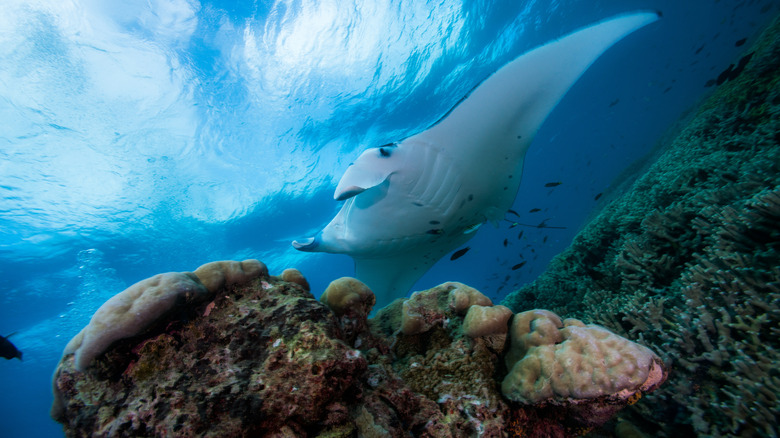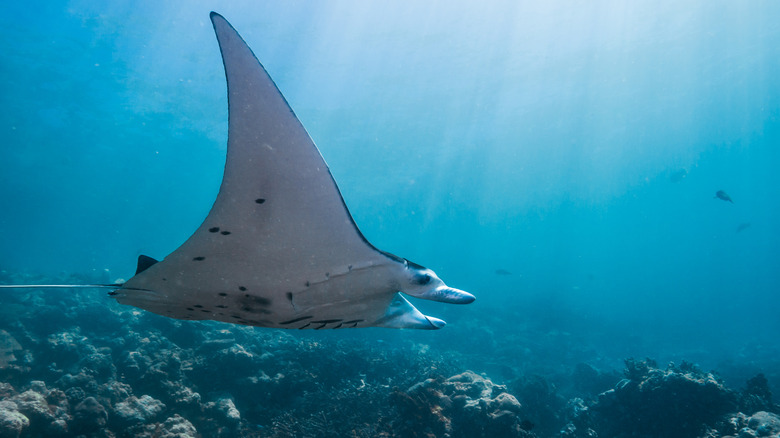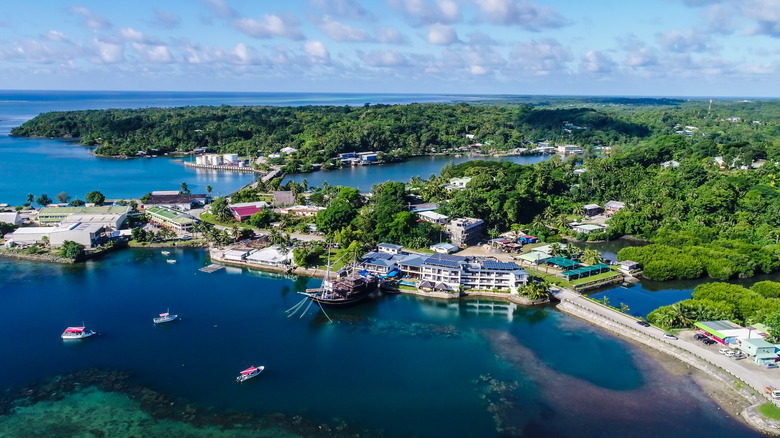The World's First Manta Ray Sanctuary Is A Remote Snorkeling And Diving Island Paradise In Micronesia
In the remotest reaches of the North Pacific lies a hidden aquatic wonderland for marine life big and small. Under the ocean's tranquil surface, manta rays play in sun-dappled waters. Vibrant tropical fish search for snacks among delicate corals. Hunting octopi crawl across the sand. And grey and white-tip reef sharks swim through large caverns. This is Yap, an underrated island in Micronesia that's ideal for a serene escape. This stunning archipelago consists of four main volcanic islands, with its namesake being the largest, and various atolls. It's surrounded by peaceful, cerulean lagoons and situated within a barrier reef.
While this area is rich in biodiversity, the star of the show is arguably Yap's manta ray population. The particular species found here is the reef manta ray (Mobula alfredi). And although it's not as large as its oceanic cousin, it's still impressive, with a wingspan of up to 15 feet and a maximum weight of 1,860 pounds. These graceful giants play such an important role here that Yap's own tagline is "Mystical Micronesia where Mantas dance." It's even one of the field research sites for Manta Trust, which studies the animals, develops conservation strategies, and identifies individuals. And in August of 2008, the world's first manta ray sanctuary was established to protect these marine creatures and their habitat from overfishing and other negative human impacts.
The sanctuary was put into motion by conservationist Bill Acker, who opened Yap's first diving operation in the capital, Colonia, in 1986. Yap Divers is an SSI Platinum Dive Center as well as a PADI five-star facility located in the eco-friendly Manta Ray Bay Resort (also opened by Acker, in 1990). And if you'd like to interact with these spectacular mantas, then going on a snorkeling or diving excursion with Yap Divers is a must.
How to experience the manta rays of Yap, Micronesia
When booking a trip to Yap with Manta Ray Bay Resort, keep in mind that the best value for money is their combined packages. For example, the 7-night stay and dive package costs $1,799 per diver and will cover your stay in a standard room, breakfast, coffee and tea, 15 dives, lunch on dive days, late check-out, airport transfers, and taxes. Stay and snorkel packages are around the same price, as the guided trips are usually full-day affairs and include additional activities such as kayaking and hiking.
Once at sea, your guide will take you to the perfect spot. Divers can kneel in the sand and comfortably wait for the mantas' arrival at the cleaning station, where hungry butterflyfish and wrasses remove irritating parasites from their bodies. Yap's resident mantas are used to the presence of humans, so they may hover just a few feet away. The cleaning station is shallow, so dive times will be long (55 to 75 minutes on average), and the site can also be seen by snorkelers above. While manta sightings happen year-round, mating season is from December to April. At this time, you'll be able to view the mantas' unique courtship dance and interact with a wider variety of marine creatures — these include puffers, mandarinfish, sea turtles, schools of bumphead parrotfish, snappers, and reef sharks.
Remember that you should never touch anything while snorkeling or diving, as the oils and bacteria on your hands can be harmful. If a manta passes overhead, try not to exhale aggressively under them, as the large bubbles can obscure their vision and frighten them. And do not approach any animals — you are still a loud, bubble-blowing, mouth-breathing monstrosity to most sea critters, and your quick advance may be perceived as a threat.
Planning your stay at Manta Ray Bay Resort
There are 35 rooms to choose from at the resort in three categories: Standard View, Ocean View, and Deluxe Ocean View. Each one is unique and designed with its own special aquatic theme, matching a sea creature you might encounter. They all come with air conditioning, high-speed Internet, and drinking water, while some are even equipped with plunge pools and rock rain-showers. The crown jewel is the luxurious Queen Angelfish: It spans 385 square feet and overlooks the bay and the Mnuw, a 19th-century schooner holding the resort's restaurant. This spacious room also offers a balcony, king-size bed, private rooftop Jacuzzi, and sun deck for comfortable lounging. On the booking page, you can see images of all 35 rooms and reserve your specific selection. The nightly rate (without a package) ranges from $109.50 to $349, depending on the room type and number of guests.
Note that there are few ATMs on the island, but most hotels, including Manta Ray Bay Resort, accept credit cards. The official currency is the U.S. dollar, so if you're traveling from America, you won't need to exchange your bills. Be aware that getting to Micronesia is a bit of a task, and there's only one direct commercial connection to Yap. This 95-minute flight is run by United Airlines and departs from Antonio B. Won Pat International Airport in Guam, the lush and affordable island "where America's day begins." There are also no direct flights to Guam from the U.S. mainland, so any trip here will involve at least two connections. That being said, if waking up to a tropical sunrise and experiencing the dance of Pacific manta rays sounds like paradise to you, then a visit to Yap is certainly worth the onerous voyage.


